The source of drinking water can be either surface water based (lakes, rivers and streams) or groundwater based (aquifers). Water is always found in combination with compounds such as minerals or chemicals of one kind or another, that can be present naturally or as a result of human activity. In both cases, there could be presence of some contaminants (metals, radioactive compounds, microorganisms, among others) that have the potential to be hazardous to humans. The Water Source Protection means protecting from contamination and overuse (at the source), both water quality and quantity we drink and use, thus reducing risks to public health from exposures to contaminated water (EPA n.y; SDWF 2017).
Water source protection involves the protection of surface water sources (e.g. lakes, rivers, man made reservoirs) and groundwater sources (e.g. spring protection, dug well protection, and drilled well protection) to avoid water pollution (see also pathogens and contaminants).
While surface water sources and springs are directly exposed to human activities, groundwater sources are often protected through overlaying soil layers. However, accessing groundwater sources through dug or drilled wells allows contaminants to enter aquifers, polluting the well itself and the water in nearby lakes, rivers, or neighbouring wells, which consequently threatens both public health and the environment (MANCE n.y.).
In the past, the need for water source protection has often been neglected. As a consequence, many drinking water sources have become contaminated making water purification measures indispensible. The very slow flow of groundwater makes rehabilitation of contaminated aquifers both costly and time-intensive. While removal of pathogenic contamination through disinfection is more likely to be successful, some metals and chemical substances will permanently remain in the soil.
Recently, establishing adequate water source protection has been recognised as the most suitable and cost-effective method to keep contaminants out of drinking water and making costly water purification measures and construction of new wells unnecessary (GCC 2011; CONSERVATION ONTARIO 2009). This holds both for industrialised and developing countries.
Implementing water source protection requires a legal framework. This usually involves a protection plan, which formulates responsibilities, specific protection measures and basic rules that apply to all community members and water source users.
As many surface water sources are used for drinking water purposes, protection is vital. Generally, three basic strategies exist for protection (UNEP 2010).
- Prevention: No discharge of waste, pollutants or untreated water from domestic, industrial or agricultural use; optimised water use and practices in agriculture in order to stop nutrients from entering aquatic systems (e.g. establishing buffer zones).
- Treatment: treatment of polluted water prior to discharge; stormwater management: ensuring that run-off cannot transport pollutants into water bodies.
- Restore ecosystems: Enable or support natural rehabilitation processes.
Numerous simple preventative measures can be applied to protect springs, wells and aquifers from contamination. They are presented in the following five steps.
Step 1: Location / Site Selection of the Water Source - Never Close to Pollutant Sources
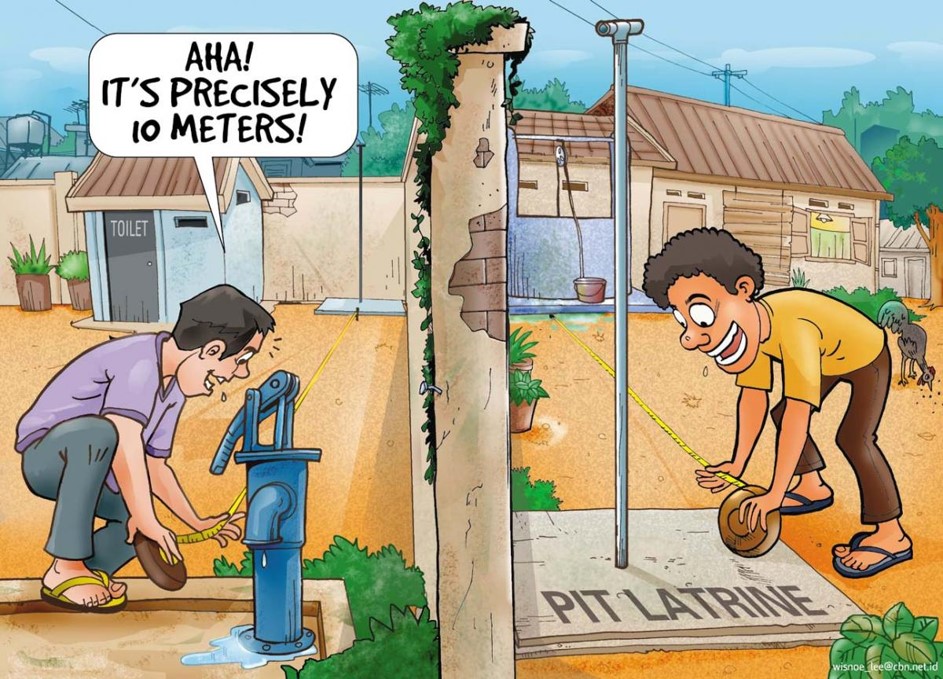
Before the drilling of a well or construction of a spring tapping starts, an appropriate site has to be found. Villagers or landowners are a good source of information and mostly point out a suitable location for them as users. However, several other important aspects have to be kept in mind when selecting the optimal site for a water source (WAL 2010).
A water point of any kind or source should be:
- Situated above the (seasonal) flood level of any nearby river or lake;
- In a location, which guarantees easy access for all water users all year round. This refers to physical access but also to legal access.
- In proximity to the actual point of water use;
- In an area allowing the rapid dispersal of spilt water;
- In a sunny area without shade to guarantee that the immediate well surroundings remain dry, so as to prevent bacteria, algae, etc. to evolve.
- In a location where the level of the water table is at a depth of at least two metres all year round (for wells);
- In distance from agricultural activities of any kind; particularly if pesticides or fertilisers are applied.
- In an area not susceptible to erosion;
- In safe distance to saltwater and any source of pollution such as a pit latrine, abattoir, dumping site, fertiliser or pesticide store, etc. (COLLINS 2000; WAL 2010).
The minimum distances to sources of pollution are given on the following table:
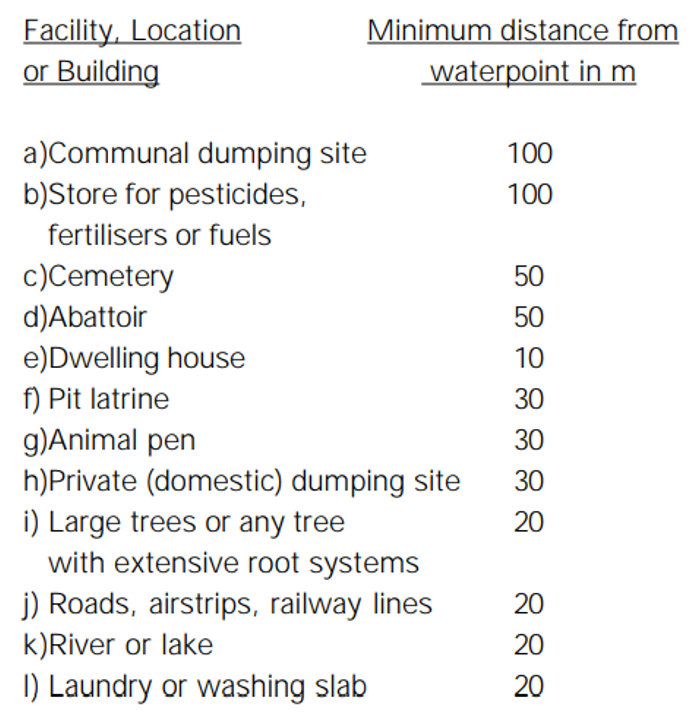
Step 2: Construction of Spring- and Well Protection
In order to protect contaminants from entering the spring, well and the aquifer through the water point itself, several specific measures can be applied:
Springs can be protected by installation of a spring tapping, a spring box and an adequate drainage system. Additionally, a surface water drainage ditch, dug above and around the spring area, diverts surface water run off from polluting the source. If the area around a spring intake is unstable or exposed to erosion, gabions or dry stone masonry can be used to stabilise the area (OXFAM 2008).
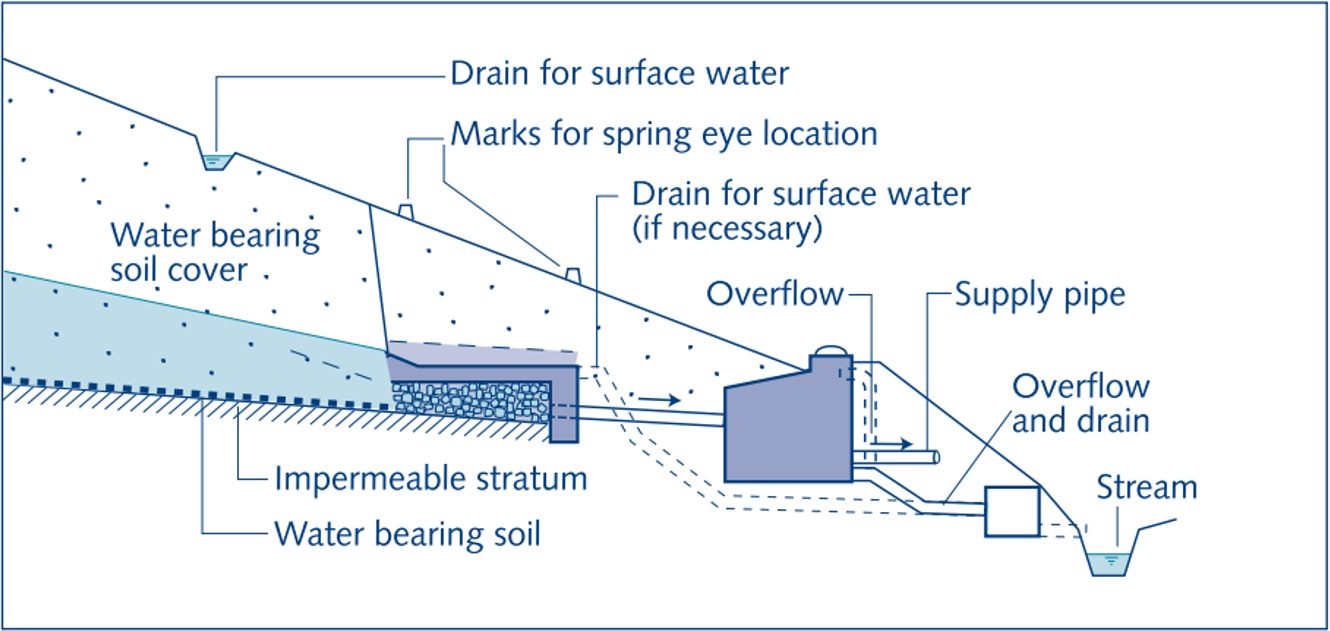
Drilled and dug wells need a proper sealing. First, an apron guarantees that no contaminants enter the well from the access point area. Second, an impermeable lining (for dug wells) or casing (for drilled wells) makes sure, that no close-to-surface-water laterally enters the well. As for springs, adequate drainage installations keep the immediate surroundings dry. After the completion of the well, a final disinfection with chlorine kills most pathogens that entered during construction.

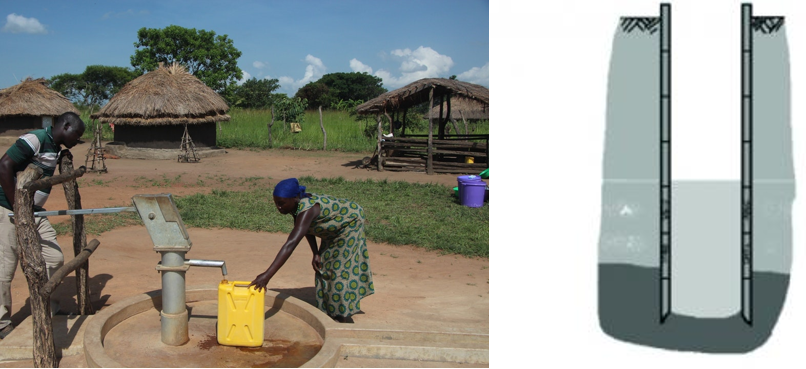
The most decent construction of a spring taping, well lining, casing and apron is without effect, if pollutants are entering the aquifer in the mediate surroundings of the water point.
In a fenced, inner protection zone (with a radius of 10 – 20 m), all activities posing a risk of contamination are restricted (e.g. farming, grazing, firing, application of pesticides and fertilisers, construction of latrines, use of chemicals, etc.). It should only be planted with grass - all trees and bushes should be uprooted. Roots can damage the catchment by cracking the structures or by blocking the pipes. (MEULI & WEHRLE 2001).
Additionally, an extended protection zone (at least 100m in radius) should be put up. Its size depends on the depth and the type of the covering soil. The required radius thus increases if the spring catchment is close to the surface and if the soil is highly permeable (MEULI & WEHRLE 2001). E.g. if the soil mainly consists of rough sand and gravel, its permeability is rather high. The radius of the extended protection zone should then be extended to more than 150m. The area in this zone should be planted with mixed trees and bushes to prevent erosion and heavy run-off. The planting of trees that absorb large amounts of water (such as eucalyptus) is not recommended for the protection zone. Examples of more useful trees include cypress and pine. However, local varieties, which do not absorb large quantities of water, should be given priority. (MEULI & WEHRLE 2001).
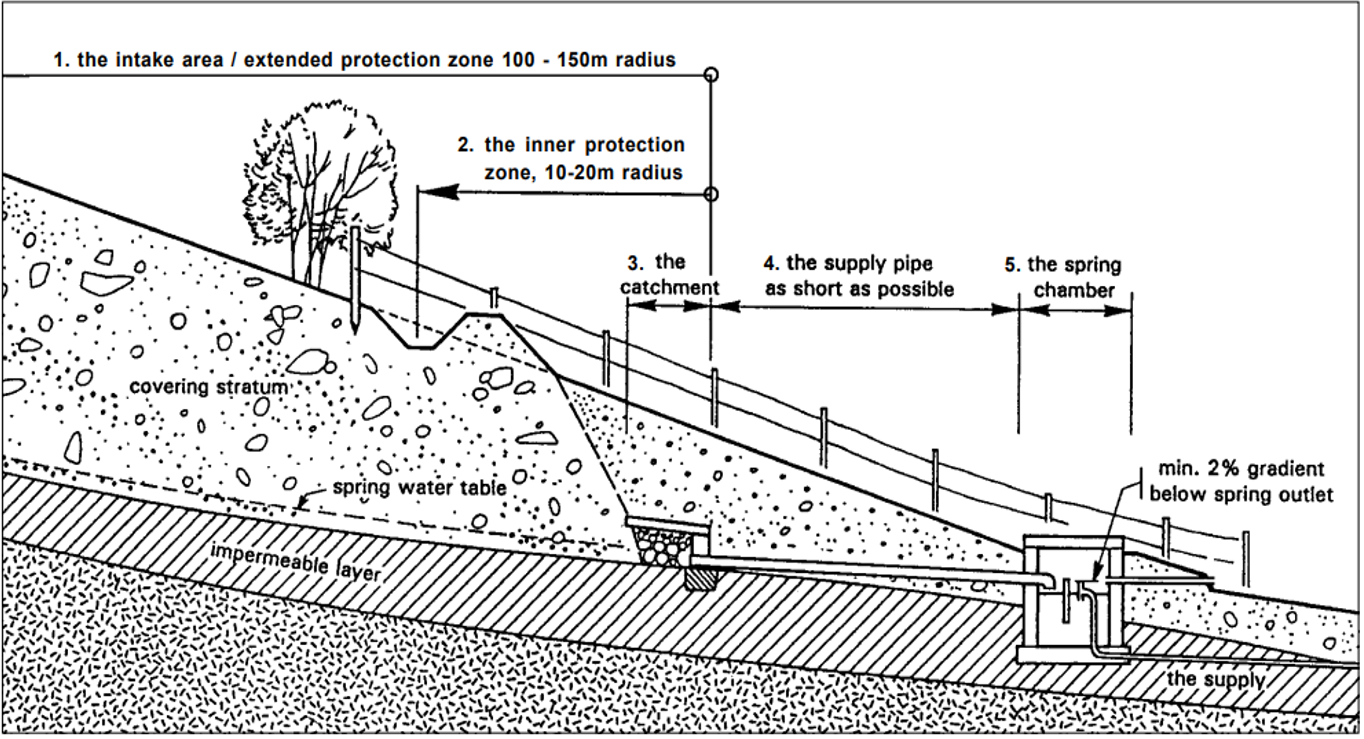
Step 3: Fencing
Fences build around the water source precisely mark the inner protection zone and prevent animals from entering, defecating or destroying installations. Fencing is mainly applied for springs, as they are more susceptible to superficial contamination. However, shallow wells may also need protection zones. It is advisable to fence the inner protection zone with barbed wire and preferably to support the wire by planting a solid hedge of solid bushes around the fence (MEULI & WEHRLE 2001).
In many countries, groundwater protection zones are regulated institutionally. Specific rules define what kinds of activities are allowed in each of the protection zone levels (they may include more than two protection levels!). They can range up to several kilometres in diameter and allow everything between no activities and nearly all activities. In Switzerland, for example, the government has defined three levels of protection zones(WPO 1998):
- "S1 Wellhead protection zone: The zone S1 comprises the area immediately surrounding a groundwater well or artificial recharge facility (at least 10 m around the well and around the collection system). In this zone, only construction work and activities connected with drinking water supply are permitted. The aim is to prevent damage to the facilities or direct contamination of the water abstracted. The zone S1 should therefore be purchased and fenced in by the drinking water supplier.
- S2 Inner protection zone: The inner protection zone S2 is primarily designed to prevent contamination of drinking water with pathogenic microorganisms and to ensure that groundwater flows are not adversely affected or obstructed as they approach the well. In this zone, the spreading of liquid manure is therefore prohibited, as are the infiltration of wastewater and the construction of buildings and installations.
- S3 Outer protection zone: The outer protection zone is designed to ensure that, in the event of an accident, sufficient time and space are available to ward off any hazards to drinking water. Thus, facilities that pose a hazard to groundwater (e.g. petrol stations) are not allowed to be located in zone S3. Wastewater seepage and gravel extraction are likewise prohibited in this area.”
Step 4: Set up Rules for all Community Members
Any protection plan rises and falls with the behaviour of the community members, their attitude towards the plan and their knowledge. Besides the installation of constructional measures, simple rules should be set up and communicated by a local caretaker.
Such rules can include:
- Don’t defecate close to the well,
- Don’t let your animals graze close to the well,
- Don’t throw any garbage into the well, etc.
Step 5: Management of Operation and Maintenance
Only adequate operation by the water users and frequent maintenance by a local caretaker can ensure a safe long-term usability of the water point. Operation and maintenance activities are best organised through a local management plan.
The remit of a caretaker involves the:
- Inspection, cleaning and repair of spring installations and well (e.g. cracks in the apron, leaking parts, etc.)
- Monitoring activities in the surrounding area
- Up keeping the protection zone/ repair of the fence
- Checking for appropriate operation by users and providing health education(OXFAM 2008).
- Checking whether the basic rules are respected by the users
Step 6: Abandoned and Unused Wells
Abandoned wells are wells that are no longer in use. Over the years, many wells around homes and farms have been abandoned without being properly sealed and decommissioned. Abandoned wells or improperly decommissioned wells can pose a serious threat to groundwater quality and can also be a safety hazard. Therefore, all abandoned wells should be properly plugged to prevent contamination and to eliminate any safety hazards. When a new water well has to be drilled, the old well should be plugged (MANCE n.y.). See MANCE (n.y.) to learn how to decommission and plug a well properly.
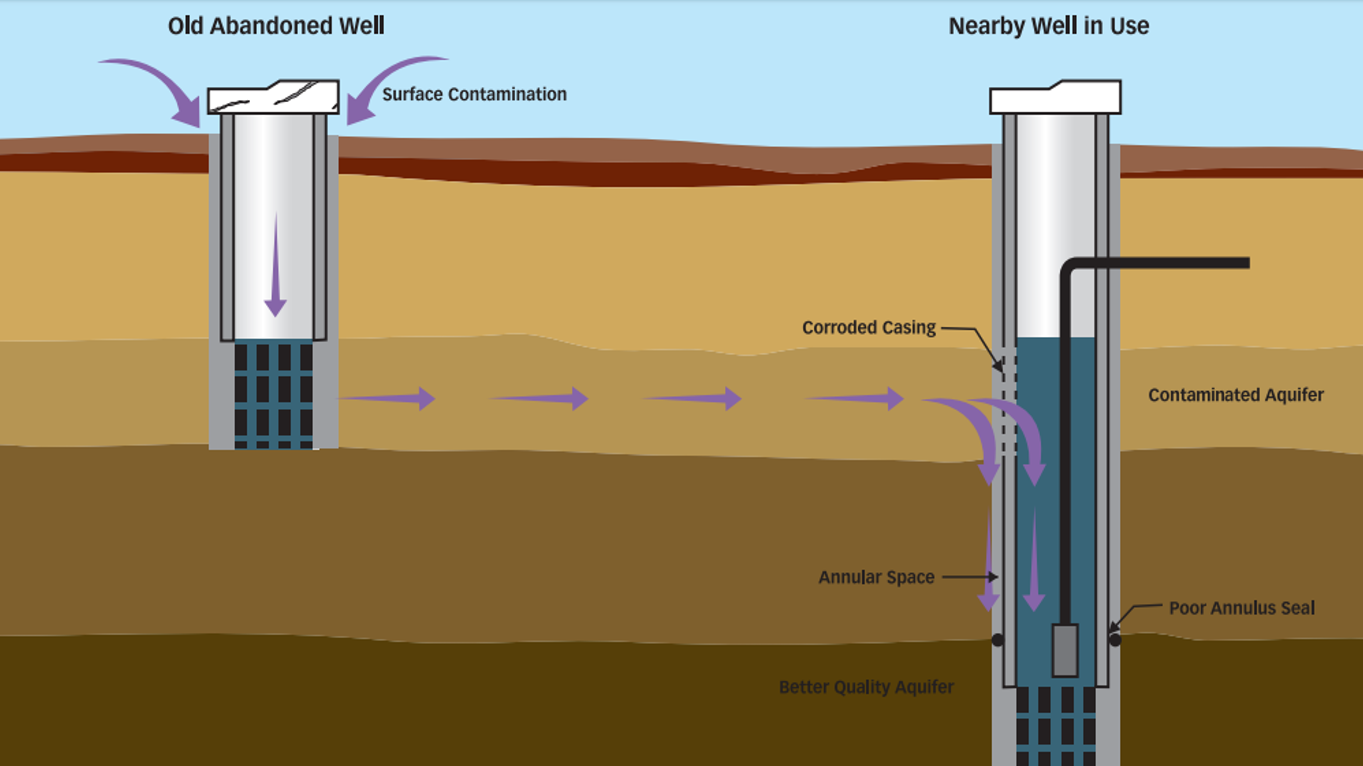
Abandoned wells:
- Can allow surface run off to directly enter an aquifer, contaminating the aquifer and potentially contaminating nearby wells;
- Can permit cross-contamination of different aquifers encountered by the well bore;
- Can be a physical safety threat, as they are often not marked or covered, and can pose a hazard to people or animals that might fall into them;
- Can be a liability problem if the well contaminates neighbouring wells, or if the abandoned well still exists at the time of property resale (MANCE n.y.).
Increasingly, water planners and communities are looking to source water protection as a key to improve water quality and lowering water purification costs. Focusing on the protection of the drinking water sources in order to reduce or eliminate the need for purification is a more sustainable approach than cleaning the water once it is polluted.
Protection measures are simple and can be constructed with locally available material by local people; consequently, costs are relatively low. Basic rules for community members can quickly be set up and communicated. The tricky part is keeping the water sources well maintained and making sure that people respect the basic rules that come with the measures.
Also, healthy, resilient ecosystems help to purify water, regulate the water cycle, and thereby degrade many contaminants before they enter and pollute water sources (UNEP 2010).
All in all, water source protection keeps contaminants out of drinking water and is often more cost-effective than removing contaminants after the water source has been polluted (GCC 2011).
Hand-dug Shallow Wells
This highly recommended publication comprises everything regarding the establishment of a water supply system based on (shallow) hand-dug wells for communities in the South. It elaborates on the underlying hydrogeological principles, preparatory investigations, design, construction, operation and maintenance, and it discusses the most common mistakes made in design and construction.
COLLINS, S. (2000): Hand-dug Shallow Wells. (= Series of Manuals on Drinking Water Supply , 5 ). St. Gallen: Swiss Centre for Development Cooperation in Technology and Management (SKAT) URL [Visita: 08.03.2019] PDFBasic Information about Source Water Protection
Protected dug well in Gulu (Uganda)
A Landowner’s Guide to Water Wall Management
This well-illustrated publication provides information on most aspects of well management: basics of groundwater hydrology, water well development (including planning, design, construction, management and maintenance), and well protection are introduced in very clear language and by means of nice graphs and illustrations.
MANCE, E. (n.y): A Landowner’s Guide to Water Wall Management. Ottawa: Agriculture and Agri-Food Canada URL [Visita: 08.03.2019] PDFSpring Catchment
This highly recommended publication comprises everything regarding the establishment of a spring-based water supply system. It elaborates on the underlying hydrogeological principles, preparatory investigations, design, construction, operation and maintenance, and it discusses the most common mistakes made on spring catchments.
MEULI, C. WEHRLE, K. (2001): Spring Catchment. (= Series of Manuals on Drinking Water Supply , 4 ). St. Gallen: Swiss Centre for Development Cooperation in Technology and Management (SKAT) URL [Visita: 08.03.2019] PDFSpring Protection. Technical Brief
This Technical Brief looks at spring protection including the catchment area, the immediate area around the spring and the construction of spring boxes. It also highlights two methods of reducing sediments in the water coming from large springs and introduces alternative protection methods to spring boxes.
OXFAM (2008): Spring Protection. Technical Brief. Oxford: Oxfam International URL [Visita: 08.03.2019] PDFSource Water Protection
Small Community Water Supplies: Technology, People and Partnership: Spring Water Tapping - Chapter 8
This book provides a general introduction to a wide range of technologies. Among the topics covered are: planning and management of small water supplies, community water supplies in Central and Eastern European countries, water quality and quantity, integrated water resources management, artificial recharge, rainwater harvesting, spring water tapping, groundwater withdrawal, water lifting, surface water intake, water treatment, aeration, coagulation and flocculation, sedimentation, multi-stage filtration, desalination technology, disinfection, household level water treatment, technologies for arsenic and iron removal from ground water, and emergency and disaster water supply.
SMET, J. ; WIJK, C. van (2002): Small Community Water Supplies: Technology, People and Partnership: Spring Water Tapping - Chapter 8. The Hague: International Water and Sanitation Centre (IRC), pp. 151-168. URL [Visita: 08.03.2019] PDFClearing the Waters. A Focus on Water Quality Solutions
This report by UNEP provides an overview of current major water quality contaminants and the human activities that affect water quality. It details the impacts that poor water quality has on the environment, human health, and vulnerable communities, and quantifies the economic costs of poor water quality. Il also offers insights into specific solutions available to address water quality problems.
UNEP (2010): Clearing the Waters. A Focus on Water Quality Solutions. Oakland: United Nations Environment Programme (UNEP) URL [Visita: 08.03.2019] PDFUnderstanding Groundwater & Wells in Manual Drilling. Instruction Handbook for Manual Drilling Teams on Hydro-geology for Well Drilling, Well Installation and Well Development
The manual ‘Understanding Groundwater & Wells in manual drilling’ complements the 4 technical training handbooks and highlights those essential subjects which are relevant to manual drilling, geo-hydrology, hygiene, well installation and well development in practice, in simple and understandable language.
WAL, A. van der (2010): Understanding Groundwater & Wells in Manual Drilling. Instruction Handbook for Manual Drilling Teams on Hydro-geology for Well Drilling, Well Installation and Well Development. Papendrecht: PRACTICA Foundation URL [Visita: 21.03.2012] PDFWellhead Protection: A Guide for Arizona Communities
After a short introduction (basic aspects of groundwater hydrology and contamination), a five-step-approach for developing a local well protection plan is presented.
WALLIN, R. (1997): Wellhead Protection: A Guide for Arizona Communities. TUCSON: Arizona Department of Environmental Quality, Water Quality Division URL [Visita: 17.04.2012]Latrines Comic
Judicious management of groundwater through participatory hydrological monitoring
This report developed under the APWELL project deals with participatory hydrological monitoring in an effort to sensitize the individual groundwater users on judicious use of groundwater. Participatory hydrological monitoring improves the users’ understanding of local groundwater resource characteristics and helps local communities to form a community opinion to support appropriate measures for managing the available resources equitably.
APWELL Project (2003): Judicious management of groundwater through participatory hydrological monitoring. A manual. Andhra Pradesh, India.: Andhra Pradesh Groundwater Bore well Irrigation Schemes Project (APWELL Project) URL [Visita: 15.01.2013]A Landowner’s Guide to Water Wall Management
This well-illustrated publication provides information on most aspects of well management: basics of groundwater hydrology, water well development (including planning, design, construction, management and maintenance), and well protection are introduced in very clear language and by means of nice graphs and illustrations.
MANCE, E. (n.y): A Landowner’s Guide to Water Wall Management. Ottawa: Agriculture and Agri-Food Canada URL [Visita: 08.03.2019] PDFSpring Catchment
This highly recommended publication comprises everything regarding the establishment of a spring-based water supply system. It elaborates on the underlying hydrogeological principles, preparatory investigations, design, construction, operation and maintenance, and it discusses the most common mistakes made on spring catchments.
MEULI, C. WEHRLE, K. (2001): Spring Catchment. (= Series of Manuals on Drinking Water Supply , 4 ). St. Gallen: Swiss Centre for Development Cooperation in Technology and Management (SKAT) URL [Visita: 08.03.2019] PDFSpring Protection. Technical Brief
This Technical Brief looks at spring protection including the catchment area, the immediate area around the spring and the construction of spring boxes. It also highlights two methods of reducing sediments in the water coming from large springs and introduces alternative protection methods to spring boxes.
OXFAM (2008): Spring Protection. Technical Brief. Oxford: Oxfam International URL [Visita: 08.03.2019] PDFClearing the Waters. A Focus on Water Quality Solutions
This report by UNEP provides an overview of current major water quality contaminants and the human activities that affect water quality. It details the impacts that poor water quality has on the environment, human health, and vulnerable communities, and quantifies the economic costs of poor water quality. Il also offers insights into specific solutions available to address water quality problems.
UNEP (2010): Clearing the Waters. A Focus on Water Quality Solutions. Oakland: United Nations Environment Programme (UNEP) URL [Visita: 08.03.2019] PDFWater Catchment Protection Handbook
This document provided by Helvetas Cameroon describes an approach for the organisational and technical implementation of water catchment protection. This approach consists of 8 steps including sensitisation, feasibility studies, protection plans, land ownership, implementation, O&M, monitoring, and evaluation. This step-wise approach can be used as a guideline for implementing water catchment activities in village water supply systems.
WAARDE, J. van der MUSA, T.M. ISCHER, M. (n.y): Water Catchment Protection Handbook. (= Learning and Experience Sharing Series , 1 ). Bamenda: Helvetas Cameroon, Swiss Association for International Co-operation URL [Visita: 08.03.2019] PDFUnderstanding Groundwater & Wells in Manual Drilling. Instruction Handbook for Manual Drilling Teams on Hydro-geology for Well Drilling, Well Installation and Well Development
The manual ‘Understanding Groundwater & Wells in manual drilling’ complements the 4 technical training handbooks and highlights those essential subjects which are relevant to manual drilling, geo-hydrology, hygiene, well installation and well development in practice, in simple and understandable language.
WAL, A. van der (2010): Understanding Groundwater & Wells in Manual Drilling. Instruction Handbook for Manual Drilling Teams on Hydro-geology for Well Drilling, Well Installation and Well Development. Papendrecht: PRACTICA Foundation URL [Visita: 21.03.2012] PDFProtecting Groundwater for Health. Managing the Quality of Drinking-water Sources
Protecting drinking-water resources is the first barrier to pathogens and substances hazardous to health. This very comprehensive book presents tools for developing strategies to protect groundwater for health by managing the quality of drinking-water sources.
WHO (2006): Protecting Groundwater for Health. Managing the Quality of Drinking-water Sources. London: World Heath Organization (WHO) URL [Visita: 17.04.2012]Pit Latrines and Their Impacts on Groundwater Quality: a systematic Review
This study reviews empirical studies on the impact of pit latrines on groundwater quality and identifies knowledge gaps regarding the potential and consequences of groundwater contamination by latrines.
Graham, J. ; Polizotto, M.L. (2013): Pit Latrines and Their Impacts on Groundwater Quality: a systematic Review. Advance Publication. Entradas: Environmental Health Perspectives: URL [Visita: 09.04.2013]Biological Wastewater Treatment in Warm Climate Regions Volume 1
Biological Wastewater Treatment in Warm Climate Regions gives a state-of-the-art presentation of the science and technology of biological wastewater treatment, particularly domestic sewage. The book covers the main treatment processes used worldwide with wastewater treatment in warm climate regions given a particular emphasis where simple, affordable and sustainable solutions are required. The 55 chapters are divided into 7 parts over two volumes: Volume One: (1) Introduction to wastewater characteristics, treatment and disposal; (2) Basic principles of wastewater treatment; (3) Stabilisation ponds; (4) Anaerobic reactors; Volume Two (also available in the SSWM library): (5) Activated sludge; (6) Aerobic biofilm reactors; (7) Sludge treatment and disposal.
SPERLING, M. von LEMOS CHERNICHARO, C.A. de (2005): Biological Wastewater Treatment in Warm Climate Regions Volume 1. London: International Water Association (IWA) Publishing URL [Visita: 26.05.2019]Leeuwin Spring Catchment Area and Fisher Road Wellfield Water Reserve Drinking Water Source Protection Plan
A safe drinking water supply is critical to the well being of the community and catchment protection is necessary to help avoid, minimise or manage risks to water quality. This document analyses the current situation of two springs in Australia and proposes how protection could be enhanced and implemented.
DOW (2007): Leeuwin Spring Catchment Area and Fisher Road Wellfield Water Reserve Drinking Water Source Protection Plan. Perth: Department of Water (DOW) URL [Visita: 08.03.2019] PDFHelvetas Cameroon Experiances in Catchment Protection Activities. Assessment
Helvetas Cameroon has been active for more than 10 years in water catchment protection in the North West Province. In this report a review is presented of the activities performed by Helvetas Cameroon in water catchment protection and the best practises are summarised.
WAARDE, J.J. van der (2004): Helvetas Cameroon Experiances in Catchment Protection Activities. Assessment. Bamenda: Helvetas Cameroon URL [Visita: 08.03.2019] PDFWellhead Protection: A Guide for Arizona Communities
After a short introduction (basic aspects of groundwater hydrology and contamination), a five-step-approach for developing a local well protection plan is presented.
WALLIN, R. (1997): Wellhead Protection: A Guide for Arizona Communities. TUCSON: Arizona Department of Environmental Quality, Water Quality Division URL [Visita: 17.04.2012]Drainage from Water Points
This poster is part of the series of Water, Sanitation and Hygiene posters designed by the Water, Engineering and Development Center of Loughborough University.
SKINNER, B.H. CHATTERTON, K. SHAW, R. (2013): Drainage from Water Points. Poster. (= WEDC Posters , 7 ). London: Water, Engineering and Development Center (WEDC) URL [Visita: 28.08.2013] PDFWater Wells ...the last for generations
This workbook, compiled by Agriculture and Agri-Food Canada, and the Government of Alberta, contains 12 modules helping you to ensure long-term operability of your well. Regarding well protection, particularly modules 6, 8, 9 and 10 are of interest.
Wellhead protection
This manual by the Public Water Supply Systems in Nebraska suggests a step-by-step guide to the completion of the Wellhead protection area management planning process on a community-based level.
Handpump Technologies
The Rural Water Supply Network is a global knowledge network for rural water supply technologies and approaches. The website provides many excellent publications on various topics on rural development, particularly on hand pumping technologies. This section presents an overview of the different manual pumps for drinking water.
Rivers Network
This open-source platform has dedicated itself to spread knowledge and awareness about the river basins of the world. It provides geographically specific information as a basis for improving sustainable management of rivers.


